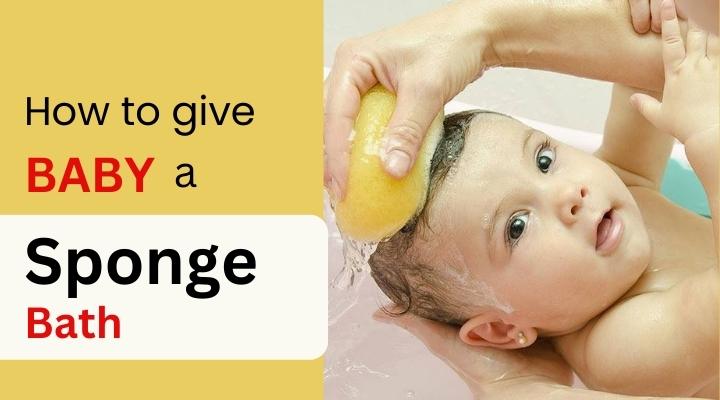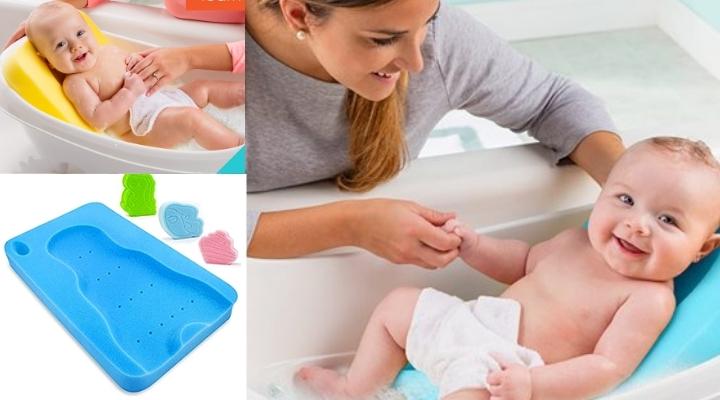How To Give Baby A Sponge Bath?
As a new parent, one of the essential skills you’ll need to master is giving your baby a sponge bath. Bath time is not just a routine for cleanliness; it also offers valuable bonding time with your little one. In this article, we will explore “How to Give Baby a Sponge Bath”. Bathing a baby can be an enjoyable and bonding experience for both parents and their little ones. While regular baths are essential for keeping babies clean and comfortable, there may be times when giving a full bath is not possible or recommended. For instance, when a baby has a healing umbilical cord stump or a circumcision site, a sponge bath becomes the ideal alternative. Sponge baths are also suitable for newborns until their umbilical cord stump falls off, which typically happens within the first two weeks of life. To ensure your baby’s safety and comfort during this process, we have compiled a comprehensive step-by-step guide on properly sponge bath a baby.
Why Sponge Bathing?
During the first weeks of life, newborns have delicate and sensitive skin that requires special care. Sponge baths are gentle and effective ways to clean your baby’s delicate skin without submerging them in water. Sponge baths are recommended until the umbilical cord stump falls off and the circumcision (if applicable) heals. This usually takes around two to four weeks. Sponge baths are gentle, hygienic, and help prevent infections. Newborns have an immature immune system, making them more susceptible to infections and skin irritations. Sponge baths help maintain hygiene without causing undue stress on their developing systems.
Preparing for the Sponge Bath
Before starting the sponge bath, gather all the necessary supplies and make sure the room is warm and draft-free. You will need:
A clean, soft washcloth or sponge-
Use a washcloth made of soft, hypoallergenic material that is specifically designed for baby care. Avoid rough textures that could irritate their skin.
Related-Must-Know Tips About Diapering – Every Parent Should Know
Warm water-
Fill a basin or clean sink with warm (not hot) water. Check the water temperature with your elbow or the inside of your wrist to ensure it’s not too hot for the baby.
Mild baby soap or cleanser (optional)-
If you choose to use soap during the sponge bath, pick a gentle, baby-specific soap that is free from harsh chemicals and fragrances.
Clean towels-
Have a few soft, absorbent towels nearby to dry your baby after the bath.
Diaper and clothes-
Have a clean diaper and clothes ready for the baby once the sponge bath is complete.
A soft surface-
Place a soft, clean towel or baby changing pad on a flat, stable surface (like a changing table or bed) to lay your baby on during the sponge bath.
Related- 21 Most Famous Rhyming Poems For Kids
Step-by-Step Guide to Sponge Bathing Your Baby
Now that you have everything ready, let’s go through the step-by-step process of sponge bathing your baby:
Step 1- Wash Your Hands
Before you begin, wash your hands thoroughly with soap and warm water. This helps prevent the transfer of germs to your baby’s sensitive skin.
Step 2- Undress Your Baby
Gently undress your baby, removing all clothes except the diaper. Wrap your baby in a soft towel or blanket to keep them warm while you’re bathing one body part at a time.
Step 3- Clean Your Baby’s Face
Dampen a soft washcloth or sponge with warm water and gently wipe your baby’s eyes from the inside corner to the outside. Use a separate part of the washcloth to clean each eye to avoid any cross-contamination. Clean around the ears, but avoid inserting the cloth into the ear canal.
Step 4- Clean the Ears and Neck
Use a damp corner of the washcloth to gently clean behind your baby’s ears and neck folds. Be sure to dry these areas carefully to prevent moisture buildup.
Step 5- Clean the Body
Dip the sponge or washcloth into the warm water and wring out the excess. Starting from the top and working your way down, gently wipe your baby’s arms, chest, tummy, and back. Pay special attention to skin folds, such as armpits and thighs, as these areas tend to accumulate more dirt and moisture.
Step 6- Clean the Genital Area
Gently lift your baby’s legs and clean their genital area thoroughly. For baby girls, remember to wipe from front to back to prevent the spread of bacteria. If you have a baby boy, avoid pulling back the foreskin (if not circumcised) during this stage; it will separate naturally as your baby grows.
Step 7- Clean the Legs and Feet
After cleaning the genital area, continue to clean your baby’s legs and feet. Be sure to get between the toes and dry them properly.
Step 8- Rinse and Dry
Use a clean, damp washcloth to rinse off any soap residue from your baby’s body. Then, gently pat your baby dry with a soft, hooded towel. Make sure to dry between the folds of their skin thoroughly to prevent diaper rash.
Step 9- Moisturize (Optional)
If your baby’s skin tends to dry, you may apply a small amount of hypoallergenic baby lotion or oil to moisturize their skin.
You can also check- 10 Best Baby Massage Oils – Which Oil Is Best For Newborn
Step 10- Dress Your Baby
Once your baby is clean and dry, put on a fresh diaper and dress them in clean clothes. Ensure they are comfortably dressed, considering the room temperature.
Safety Tips for Sponge Bathing
While sponge baths are generally safe, it’s essential to take some precautions to ensure your baby’s safety and comfort:
Be gentle-
The key to a successful sponge bath is being gentle and patient with your baby. Their skin is delicate, and they may feel a bit anxious during the process, especially if it’s their first time. Use slow and steady movements to keep them comfortable.
Talk to your baby-
While giving the sponge bath, talk soothingly to your baby. Your voice can help them feel safe and secure during the bath.
Maintain eye contact-
Maintain eye contact with your baby as you proceed with the sponge bath. This eye-to-eye connection enhances the bonding experience.
Monitor the water temperature-
Make sure the water is warm but not hot. The ideal water temperature for a baby’s sponge bath is around 100°F (37.8°C). Always check the water with your elbow or wrist to avoid scalding your baby’s delicate skin.
Avoid submerging the baby-
Never attempt to submerge your baby in water during a sponge bath. This could be dangerous and unnecessary for effective cleaning.
Keep the room warm-
Babies lose body heat quickly, so keeping the room warm during the sponge bath is crucial. You can use a space heater or warm up the room before starting the bathing process.
Seek medical advice when needed-
If you notice any skin abnormalities or are concerned about your baby’s health, consult your pediatrician. They can offer guidance and ensure that your baby’s skin issues are appropriately addressed.
Sponge baths are a gentle and practical way to keep your baby clean and comfortable, especially during the period when the umbilical cord stump is healing. By following the step-by-step guide and tips provided above, you can ensure a safe and pleasant sponge bathing experience for both you and your baby. This time together fosters a strong bond and allows you to cherish precious moments with your little one while maintaining their hygiene and health.
Remember, every baby is unique and may respond differently to sponge baths. Be patient, attentive, and always prioritize their comfort and well-being. As your baby grows, they will become more accustomed to baths and water play, making it a fun experience for everyone involved.
Frequently Asked Questions
When is it safe to start giving my baby a sponge bath?
Sponge baths are recommended until the umbilical cord stump falls off (usually within 2 to 4 weeks) and the circumcision (if applicable) heals. Before this time, it’s best to avoid submerging the baby in water to prevent infections.
How often should I give my baby a sponge bath?
For newborns, sponge baths can be done 2 to 3 times a week, focusing on cleaning the areas that need attention. However, you can clean your baby’s face, neck, and diaper area more frequently as needed.
What is the ideal water temperature for a baby’s sponge bath?
The water temperature should be comfortably warm, around 100°F (37.8°C). You can test it using your elbow or the inside of your wrist to ensure it’s not too hot or cold.
What should I do if my baby doesn’t like the sponge bath?
Some babies may not enjoy bath time initially. Try to make the experience as soothing as possible by speaking softly, maintaining eye contact, and singing or talking to your baby. If they remain fussy, consider shortening the bath time and keeping it gentle until they become more comfortable.
Can I use regular soap for my baby’s sponge bath?
It’s best to use a mild, baby-specific soap that is tear-free and gentle on your baby’s sensitive skin. Regular soaps may contain harsh chemicals that can irritate their delicate skin.
How do I clean my baby’s face during a sponge bath?
Dampen a soft washcloth or sponge with warm water and gently wipe your baby’s eyes from the inside corner to the outside. Use a separate part of the washcloth to clean each eye to avoid any cross-contamination. Clean around the ears but avoid inserting the cloth into the ear canal.
Should I moisturize my baby’s skin after a sponge bath?
Moisturizing your baby’s skin after a sponge bath is optional. If your baby’s skin tends to dry, you can use a small amount of hypoallergenic baby lotion or oil to moisturize their skin.
Can I use baby wipes instead of a sponge bath?
For newborns, it’s generally recommended to avoid using baby wipes on their skin, especially during the first weeks of life. Baby wipes may contain chemicals that can be harsh on their sensitive skin. Stick to sponge baths until your baby’s skin is ready for regular bathing and baby wipes.










